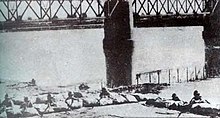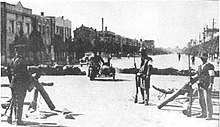Draft:Heilongjiang Province, Republic of China
| This is a draft article. It is a work in progress open to editing by anyone. Please ensure core content policies are met before publishing it as a live Wikipedia article. Find sources: Google (books · news · scholar · free images · WP refs) · FENS · JSTOR · TWL Last edited by I dream of horses (talk | contribs) 3 months ago. (Update)
Finished drafting? or |
You can help expand this article with text translated from the corresponding article in Chinese. Click [show] for important translation instructions.
|
| Heilongjiang Province 黑龍江省 | |||||||||
|---|---|---|---|---|---|---|---|---|---|
| Province of the Republic of China (1912–1948) | |||||||||
| 1912–1948 | |||||||||
 東北新省區方案之前黑龍江省的法理位置 東北新省區方案之前黑龍江省的法理位置 1947年中華民國東北新省區方案所規定的黑龍江省法理位置 1947年中華民國東北新省區方案所規定的黑龍江省法理位置 | |||||||||
| Capital | Longjiang County(1912–1931) Bei'an(1945–1948) | ||||||||
| Area | |||||||||
• | 144,950 km2 (55,970 sq mi) | ||||||||
| Population | |||||||||
• | 288,400 | ||||||||
| History | |||||||||
• Established | 1912 | ||||||||
• Disestablished | 1948 | ||||||||
| |||||||||
| Today part of | |||||||||
Heilongjiang was a province of the Republic of China. After the Second Sino-Japanese War, the nine-province plan in Northeast China was divided into Heilongjiang Province, Nenjiang Province and Hung Yen Province. The provincial capital from 1912 to 1931 was Longjiang, and from 1945 to 1948, Bei'an.
History
[edit]Feng Clan Warlord Period
[edit]It was inherited from Heilongjiang Province in the Qing Dynasty. In 1912, the Qing Dynasty was overthrown, and Heilongjiang Province opened up to Han immigrants. Later, gold mines were discovered, and gold prospectors flocked there. During the Republic of China, it was bounded by the Songhua River, with Jilin Province in the south and Heilongjiang Province in the north. It has gone through two generations of leaders, Zhang Zuolin and Zhang Xueliang.
Fengtian Incident
[edit]


During the Fengtian Incident in 1931, Japan marched into Northeast China and captured major towns in Liaoning and Jilin. On 1 October Zhang Haipeng of the Northeast Army in Heilongjiang surrendered to the enemy and sent three regiments to attack Qiqihar on the order of the Japanese army. On 16 October they were repulsed by the Heilongjiang Provincial Defense Force at Nenjiang Bridge. The defenders blew up the No. 1, No. 2, and No. 5 bridges of the Nenjiang Railway Bridge to prevent the Japanese and puppet troops from invading. On 26 October the 29th Regiment of the 2nd Division of the Kwantung Army occupied major towns along the Sitao Railway (Siping-Tao'an). On November 4, the Nenjiang detachment of the Kwantung Army attacked the defenders north of the Nenjiang Bridge. Ma Zhanshan, acting chairman of the Heilongjiang Provincial Government and acting deputy commander-in-chief of the Northeast Frontier Defense Force in Jiangsu, commanded 3 brigades and 5 regiments with a total of more than 16,000 people in the Jiangqiao Resistance War. The battle lasted until 18 November and finally abandoned the provincial capital Qiqihar due to heavy casualties. Withdraw to Keshan and Helen. On 19 November the Imperial Japanese Army captured Qiqihar.
On 28 January 1932, the 3rd Brigade of the Kwantung Army invaded Harbin from Changchun, and at the same time the 2nd Division was mobilized from the western Liaoning region for reinforcements. On 31 January, Li Du, Yilan garrison envoy and commander of the 24th Brigade, led the Jilin Self-Defense Army to defend Harbin. After five days of fierce fighting, the Self-Defense Forces suffered heavy casualties and retreated to Bin County. On 5 February, the Japanese captured Harbin.
Manchukuo
[edit]After the Fengtian Incident, Japan supported the establishment of Manchukuo. At the beginning of Manchukuo, Heilongjiang Province established a provincial office and was later divided into six provinces: Longjiang, Binjiang, Sanjiang, Heihe, Dongman, and Bei'an. During the more than ten years of occupation by the Japanese invading forces until Japan surrendered, a large amount of wood, grain, coal, and minerals were plundered and shipped to Japan.
After 1945
[edit]After Japan surrendered in 1945, the Nationalist Government actively prepared to reclaim the Northeast. It explicitly divided the three Northeast provinces into nine provinces. Xiong Shihui was appointed as the director of the Northeast camp. In early September, the provincial government of the nine Northeast provinces was appointed chairman. At the end of the same year, the Nationalist Government took over the Harbin Municipal Government from the Red Army.
In January 1946, Heilongjiang Provincial Chairman Han Junjie, Hung Yen Provincial Chairman Wu Huanzhang, Songjiang Provincial Chairman Guan Jiyu and Harbin Mayor Yang Chuoan went to Harbin to establish provincial and municipal government offices. On 25 April, all Soviet troops evacuated Harbin, and reception personnel from various provincial and municipal governments fled Harbin. On 28 April, the Northeast Democratic Alliance Army captured Harbin. Han Junjie led some provincial government personnel to Shenyang City to establish a provincial government office, but the Heilongjiang Provincial Government has never been able to go to the provincial border for office work. At the end of 1948, during the Liaoshen Campaign, most of the area was controlled by the CCP. On 2 November, the People's Liberation Army officially entered Shenyang, and the administrative structure of the Heilongjiang Provincial Government of the Republic of China was dissolved.
Heilongjiang Province of the Communist Party of China
[edit]List of governors
[edit]Kuomintang (Nationalist)
Chairperson of the Provincial Government
[edit]| № | Portrait | Name
(Birth–Death) |
Term of office | Political party | |
|---|---|---|---|---|---|
| 1 | Chang Yinhuai
龍雲 Cháng yīn huái (1876/88–1929) |
31 December 1928 | 10 January 1929 | Kuomintang | |
| 2 | 
|
Wan Fulin
万福麟 Wàn fú lín (1880–1951) |
9 February 1929 | 17 November 1931 | Kuomintang |
| 3 | 
|
Ma Zhanshan
馬占山 Mǎ zhān shān (1885–1950) |
17 November 1931 | 1 March 1932 | Kuomintang |
| 4 | 
|
Han Junjie
韓駿傑 Hán jùn jié (1894–1976) |
4 September 1945 | 2 November 1948 | Kuomintang |
| Post abolished. | |||||
